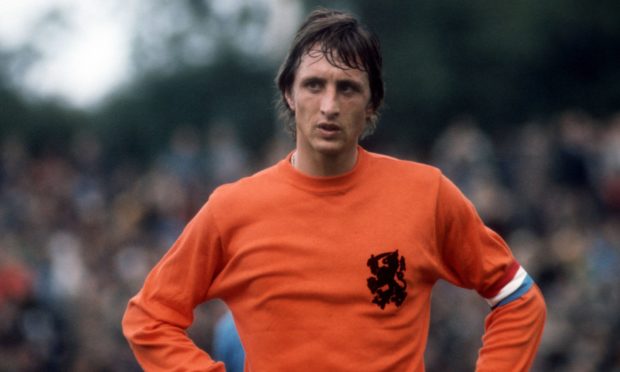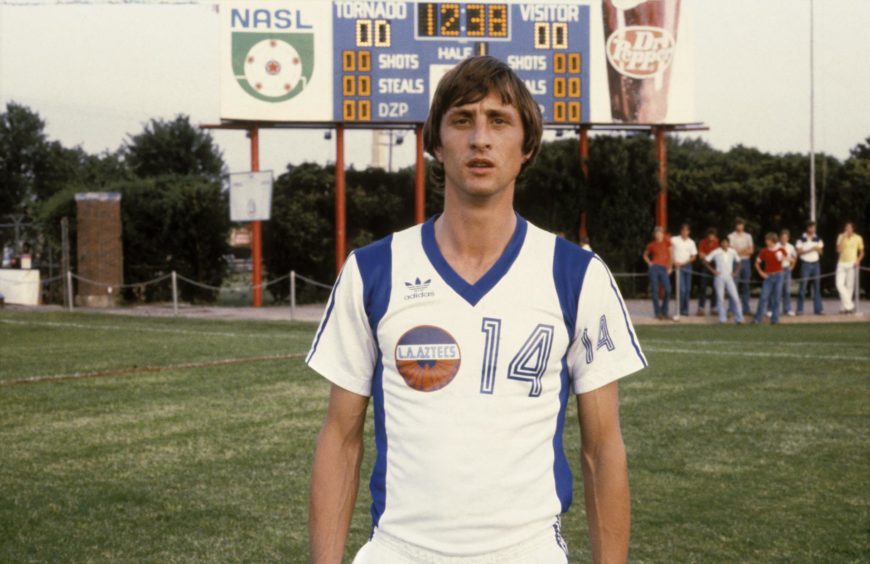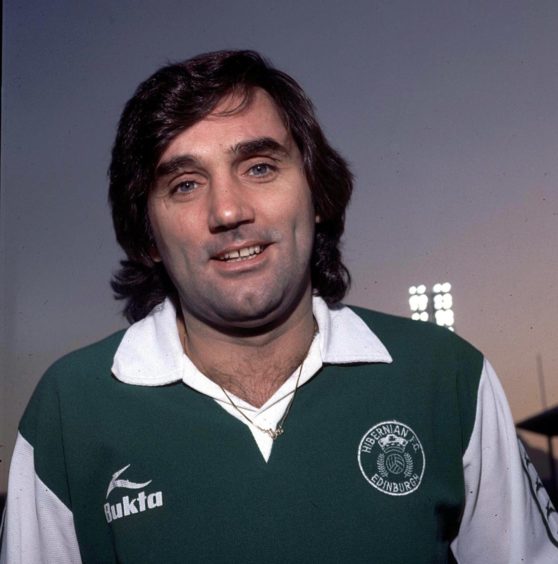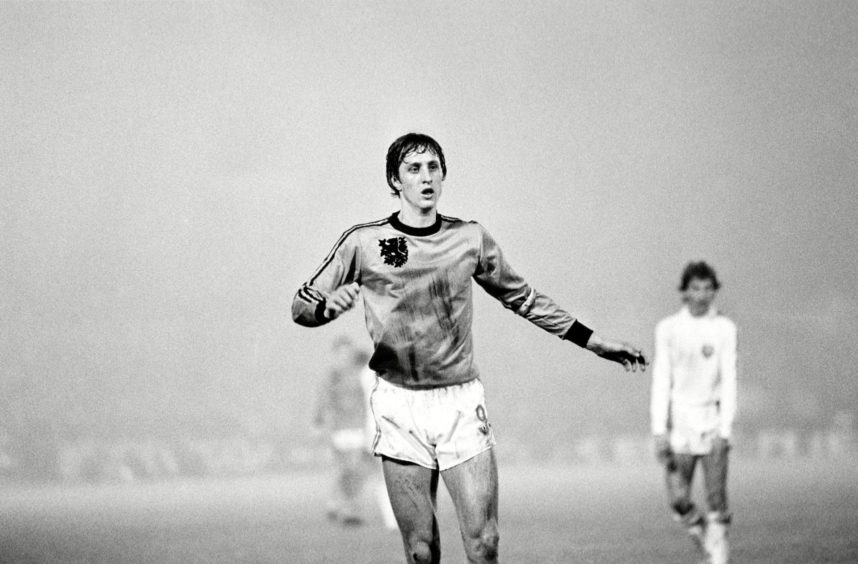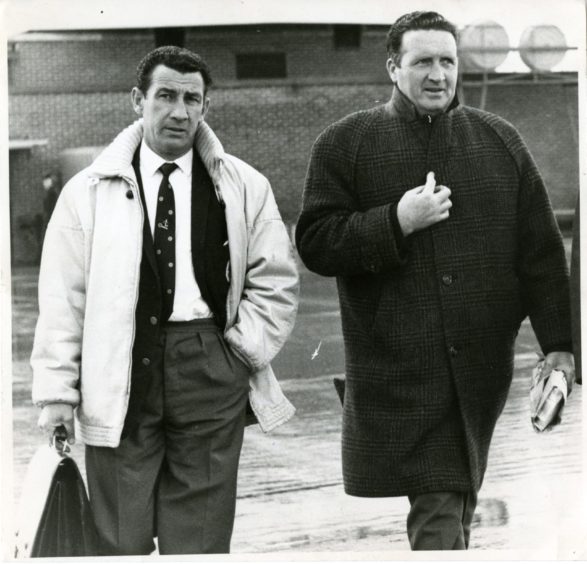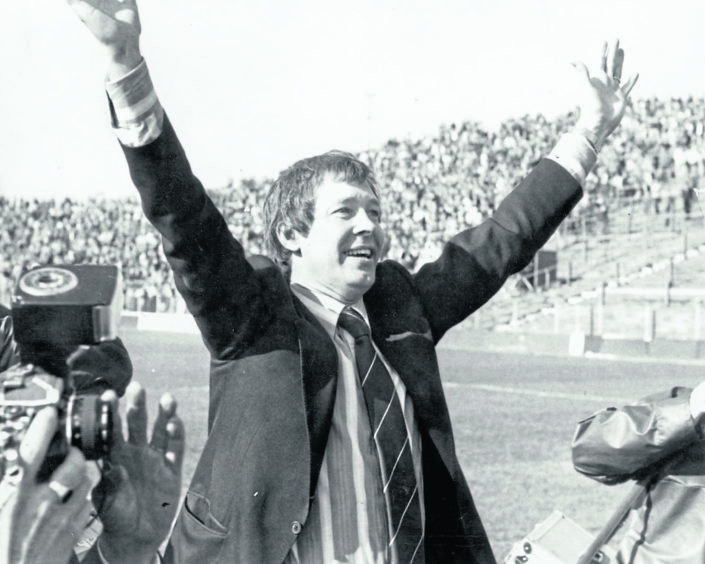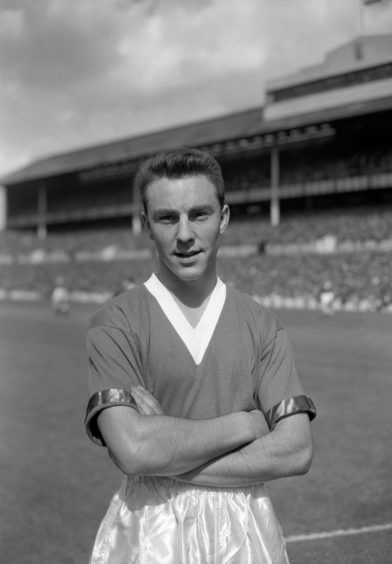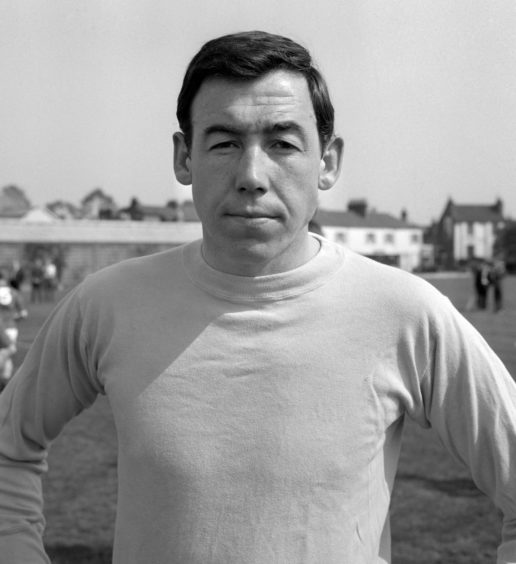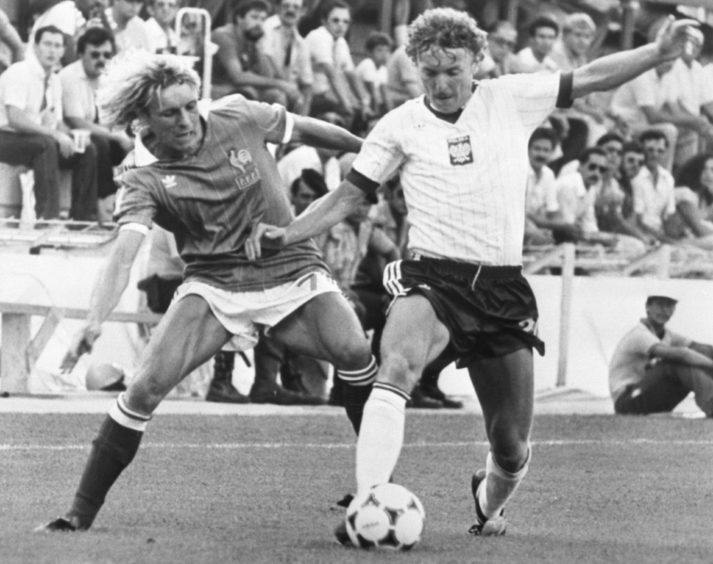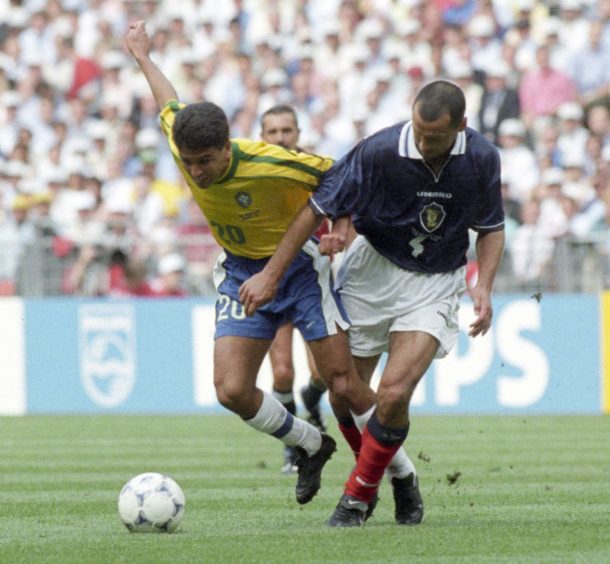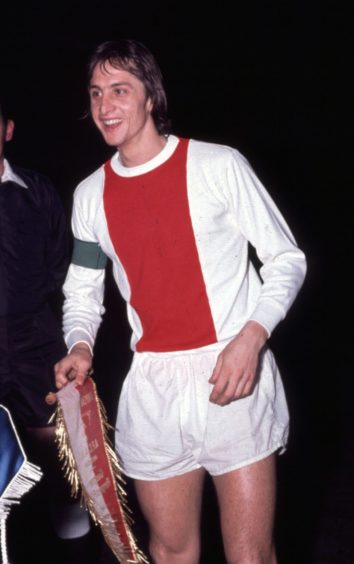As the world awoke to the tragic news of John Lennon’s death 40 years ago, Scotland’s back page headlines left football fans in just as much disbelief: “Johan Cruyff to play at Perth?”
First Division Dumbarton were in talks with the Dutch maestro who masterminded Total Football to bring the Cruyff Turn to Boghead and his first three games would have been against Ayr United, Dunfermline and St Johnstone.
Local angle
Always keen for a local angle, The Evening Telegraph suggested Cruyff would be a star attraction for bringing down the 1980 curtain at Muirton Park against St Johnstone on December 27 and his appearance might offset the Perth side’s £32,000 operating loss.
The Sons were negotiating short-term assistance from Cruyff on a pay as you play deal following a spell in the NASL in America with the Los Angeles Aztecs and the Washington Diplomats.
Dumbarton were mid-table at the time in the First Division with 19 points from their first 20 games and the club had been hit by dwindling attendances at Boghead which were sometimes below 1,000.
The signing would have seen two of the greatest players the world has ever seen in Cruyff and Manchester United legend George Best remarkably having played in Scotland’s second tier in the same season.
Best spent 325 days in Scottish football and ended his time in the First Division where he made half a dozen appearances for Hibs before a final farewell in October 1980.
Dumbarton chairman Bob Robertson had struck up a connection with Cruyff’s agent at the time which was through a mutual relationship with a major engineering company.
Pig farming
The three-time Ballon d’Or winner had always said he would retire aged 31 but returned to the game in 1978 after losing almost all of his money on a pig farming venture.
“Cruyff was struggling a bit financially in those days because he’d lost all his money in a bad investment, so we felt offering him a few thousand pounds per game might tempt him,” said the then Dumbarton manager Sean Fallon before his death in 2013.
“We needed to boost the club’s image and show the fans we were trying at Boghead so I came up with the scheme to ask Cruyff if he’d sign for us.
“I won’t argue if you call it a publicity stunt but I flew to Amsterdam and met Johan, who politely listened to what I had to say.”
Cruyff asked for a few days to consider the £2,000 per game offer from Dumbarton before he made the inevitable decision to turn down a move to Scotland.
Dumbarton would finish the season in mid-table with Hibernian going up as champions and Dundee also being promoted to the Premier League after finishing second.
When asked about the possible move to the Sons, Cruyff later said: “I was tempted.
“Of course I was.
“Playing in Britain was something I had always wanted to do.
“But I thought I was too old to go to Scotland, where you know the weather will be difficult.
“When you’re old your muscles get stiff and moving to a cold country is asking for problems.”
Leicester City
In January 1981, Cruyff played three friendly matches for FC Dordrecht in Holland but he almost did sign for a British team when he held talks with Leicester City.
Cruyff had expressed a desire to get first team action in a top European league ahead of the 1982 World Cup in Spain after the Washington Diplomats folded completely.
Foxes manager Jock Wallace thought Cruyff would be the ideal signing to keep them in the First Division where they were facing relegation and languishing in 22nd place.
A deal could not be reached and Cruyff instead chose to sign with Spanish second division side Levante and Leicester went on to be relegated.
Cruyff only played 10 times for Levante and returned to Washington to play 10 more games when the club was briefly reformed.
Marking Cruyff
The Dips folded once again and he reluctantly had to bid farewell to the States for good and he returned to Ajax where a twist of fate led to ex-Dumbarton midfielder Graeme Sinclair getting the better of him in a European Cup game in Amsterdam.
Against all the odds, Celtic beat Ajax 2-1 in the Olympic Stadium to triumph 4-3 on aggregate in September 1982 after Sinclair delivered the performance of his life to shackle the threat of Cruyff and help the Hoops progress, just six weeks after signing for the Bhoys from Dumbarton.
Cruyff would go on to lead Ajax to two Eredivisie titles in 1982 and 1983 before he crossed one of football’s great divides.
He brought the curtain down upon his remarkable playing career with bitter rivals Feyenoord where he won the league and cup double.
Success continued to come his way as he took up the coaching reins, leading Ajax to Dutch cup and European Cup Winners’ Cup glory, the latter a feat he repeated after being lured back to Barcelona, where he also won four league titles and, in 1992, the club’s first European Cup with his progressive brand of football.
There he set in place the principles that were to revolutionise the club, not just in the senior side — which became known as the Dream Team — but throughout the age groups, with every level playing in the same attractive, Cruyff-style way.
Cruyff died in March 2016 at the age 68 after a battle with cancer.
Cruyff should have played in friendly match for Aberdeen in 1979
The Dutch master was playing for Los Angeles Aztecs when he agreed to be a guest player in a four-team tournament in Malta involving Aberdeen, Stoke City, Leicester City and the Maltese international team.
England World Cup winning heroes Gordon Banks and Jimmy Greaves also agreed to take part as guests in the three-day Paro International Cup which was due to take place in December 1979.
Sir Stanley Matthews, who still lived on the island after moving to coach the Maltese side Hibernians in the early 1970s, was also set to pull on a shirt and play for Malta.
New pitch
The tournament was being staged by the Maltese FA to officially open a new pitch and Aberdeen fans also booked a seven-day holiday package to watch the tournament.
“Cruyff will pull on an Aberdeen shirt and line up in the Dons attack,” said Aberdeen manager Alex Ferguson.
“He will be just one of three guest players who will take part in a four-team tournament in Malta from December 8 to 13.
“The other two are Gordon Banks and Jimmy Greaves, the former England internationals, and each one will play for the Dons at some time during the tournament.
“The object of the tournament is to provide the soccer-mad Maltese with some good British football.
“And with Cruyff, Greaves and Banks in the line-up there will be plenty for the fans to enjoy.
“And think what a boost it will be to our players to have the great Cruyff in our dressing room pulling on a Dons jersey?
“And I’ll achieve an ambition by telling him how to play football…Aberdeen-style that is.”
Cancelled
But just 10 days before they were due to fly out to the Mediterranean the tournament was cancelled.
The Maltese government and the Maltese FA were involved in a squabble as to who should pick their international side.
Aberdeen put the disappointment behind them and went on to win the league title which was the catalyst for the glory-laden decade that followed.
Five other Scottish transfers which didn’t get over the line
In 1984 Sir Alex Ferguson tried to take advantage of the “two foreigners” rule to prise the former Poland skipper Zbigniew Boniek away from Juventus.
The deal was all set but Juve had a late change of heart.
Ronaldinho briefly looked set to be heading to St Mirren on loan in 2001, only for the transfer to collapse due to red tape.
Soon after he did move to Europe, leaving Gremio in his homeland to join Paris St Germain.
That was the same year the Buddies turned down the chance to sign the former Brazilian World Cup striker Bebeto when he was 37.
Concerned about his age, they had invited him to Love Street for a trial.
The man who had scored three goals on his way to winning the World Cup in the United States in 1994 politely declined!
In 2003, Rangers and Barcelona talked about the 16-year-old Lionel Messi going to Ibrox on loan.
Barca decided he was too young and too slight for Scottish football, so a
massive coup for Alex McLeish never happened.
Messi did eventually play at Ibrox – but for Barca on European business.
Diego Maradona’s son, Diego Junior, was also offered to First Division Clyde on loan in 2003.
He was later capped by Italy in Beach Soccer, suggesting he would have been well suited to Scotland’s heavily-sanded pitches.
Cruyff made his debut aged 17
Johan Cruyff’s father died of a heart attack when he was 12, two years after he had joined the youth system at Ajax where his mother worked as a cleaner.
Cruyff made his professional debut on November 15 1964 aged 17 when he played for Ajax against GVAV in the Dutch League.
Ajax lost 3-1, but the newcomer scored the consolation goal.
Total Football
A couple of months after making his first-team debut, Cruyff met former PE teacher Rinus Michels and together, the pair invented what’s known as Total Football.
The following season, he scored 25 times in 23 games and Ajax finished as champions.
By the time he left Amsterdam for Barcelona in 1973 for a world record fee, Cruyff had won 16 major honours, including three successive European Cups.
He went on to help the club to win La Liga for the first time since 1960, defeating Real Madrid 5-0 at the Bernabeu in the process.
The year after he moved to Spain, Cruyff’s influence took the Holland team to the World Cup Final in West Germany, where he was named player of the tournament.
Cruyff Turn
He is one of the few players ever to have had a specific on-field move named after him — the Cruyff Turn.
In a World Cup group game against Sweden, with his back to goal, Cruyff feigned a pass before dragging the ball back and turning 180 degrees to beat his defender.
He retired from international football the year before the 1978 World Cup having won 50 caps and scored 33 goals.
